
Carnival is a Western Christian festive season that occurs before the liturgical season of Lent. The main events typically occur during February or early March, during the period historically known as Shrovetide. Carnival typically involves public celebrations, including events such as parades, public street parties and other entertainments, combining some elements of a circus. Elaborate costumes and masks allow people to set aside their everyday individuality and experience a heightened sense of social unity. Participants often indulge in excessive consumption of alcohol, meat, and other foods that will be forgone during upcoming Lent. Traditionally, butter, milk, and other animal products were not consumed "excessively", rather, their stock was fully consumed during Shrovetide as to reduce waste. This festival is known for being a time of great indulgence before Lent, with drinking, overeating, and various other activities of indulgence being performed. For example, pancakes, donuts, and other desserts are prepared and eaten for a final time. During Lent, lacticinia and animal products are eaten less, and individuals make a Lenten sacrifice, thus giving up a certain object or activity of desire.

Davao del Sur, officially the Province of Davao del Sur, is a province in the Philippines located in the Davao Region in Mindanao. Its capital is Digos. Davao City is the largest city in terms of area and population within the province's jurisdiction, yet it is administratively independent from the province; as such, Davao City is only grouped for geographical and statistical purposes.
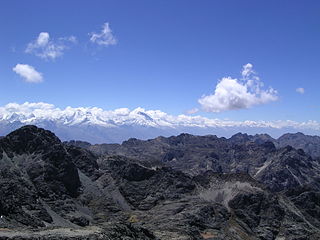
Ancash is a department and region in western Peru. It is bordered by the departments of La Libertad on the north, Huánuco and Pasco on the east, Lima on the south, and the Pacific Ocean on the west. Its capital is the city of Huaraz, and its largest city and port is Chimbote. The name of the region originates from the Quechua word anqash, from anqas ('blue') or from anka ('eagle').

Pohela Boishakh, is the first day of the Bengali calendar which is also the inspiration for official calendar of Bangladesh. This festival is celebrated on 14 April every year in Bangladesh and on either 14 or 15 April in India in the states of West Bengal, Tripura, Jharkhand and Assam by Bengalis regardless of religious faith.

Angono, officially the Municipality of Angono, is a 1st class urban municipality in the province of Rizal, Philippines. According to the 2020 census, it has a population of 130,494 people.

Graus is a village in the Spanish province of Huesca, located in the Pyrenees at the confluence of rivers Esera and Isabena. It is the administrative capital of the region. It is one of the areas of Aragon in which is still preserved the Aragonese language.

Cabana District one of eleven districts of the Pallasca Province in the Ancash Region of northern Peru.
Castellar de Santiago is a municipality in the province of Ciudad Real, Castile-La Mancha, Spain. It has a population of 1,819 inhabitants as of 2022, with a density of 20.59 people per Km². Due to its proximity, it is part of the Valdepeñas judicial district.
Pallasca District is one of 11 districts of the Pallasca Province in the Ancash region in Peru.
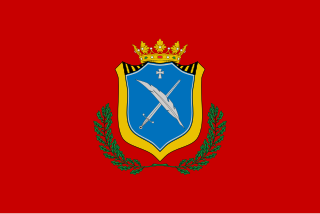
Vitigudino is a village and municipality in the province of Salamanca, western Spain, part of the autonomous community of Castile and Leon. It is located 67 kilometers from the provincial capital city of Salamanca and has a population of 2.700 people. The municipality is made up of two entities: Majuges at 3 km and Vitigudino, which is the head. In addition, the region has 56 municipalities.
Easter is one of the most significant events in the religious and social calendar, celebrated heavily in the European country of Malta.
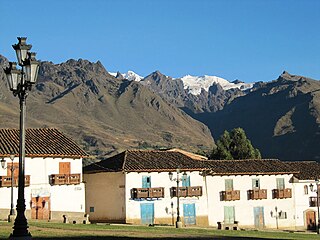
San Martín de Chacas is a Peruvian town, capital of the eponymous district and the Asunción Province, located in the east-central region of Ancash. It has an urban population of 2,082 located at 3,359 meters; and a district of 5,334 people. The district, located in the sub-basin of the Marañon River, has an area of 447.69 km², which represents 85% of the province.
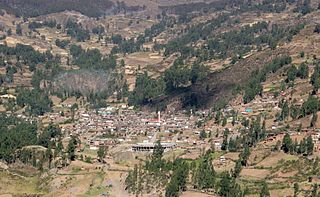
Huari is one of the 16 districts that integrates the Peruvian Huari Province in the Ancash region. The district consists of the city of Huari, 15 small villages and 22 annexes.
Laguna de Duero is a municipality located in the province of Valladolid, Castile and León, Spain. According to the 2016 census (INE), the municipality has a population of 22 ,696 inhabitants.

The District of Bolognesi is one of 11 districts which are part of the Pallasca Province in Ancash, Peru.

Dzidzantún is a town in Mexico in the northeastern Yucatan, which serves as the headquarters of the municipio or administrative unit of the Dzidzantún Municipality.
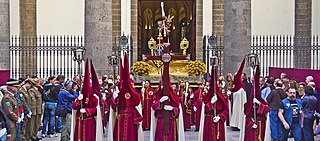
Holy Week in Spain is the annual tribute of the Passion of Jesus Christ celebrated by Catholic religious brotherhoods and fraternities that perform penance processions on the streets of almost every Spanish city and town during the Holy Week –the last week of Lent, immediately before Easter–.

Croatian national costume, also called as Croatian traditional clothing or Croatian dress, refers to the traditional clothing worn by Croats living in Croatia, Bosnia and Herzegovina, Serbia, with smaller communities in Hungary, Austria, Montenegro, and Romania. Since today Croats wear Western-style clothing on a daily basis, the national costumes are most often worn with connection to special events and celebrations, mostly at ethnic festivals, religious holidays, weddings, and by dancing groups who dance the traditional Croatian kolo, or circle dance.
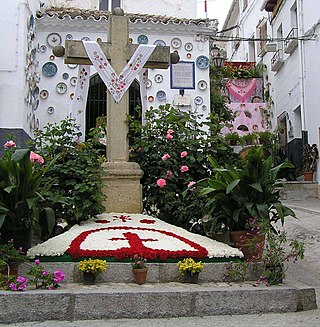
The Fiesta de las Cruces or Cruz de Mayo is a holiday celebrated on 3 May in many parts of Spain and Hispanic America.
Numerous events and festivals are held annually in Metro Manila. They include:

















